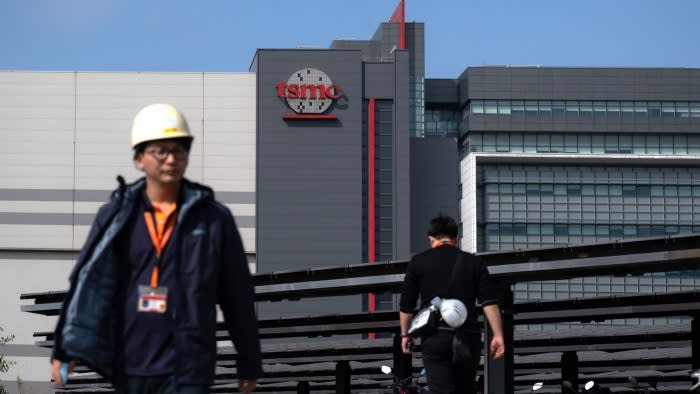Taiwan’s laboured energy transition is straining its industry, with sudden electricity price jumps and growing outage risks affecting companies including Asia’s biggest — the semiconductor giant TSMC.
Following a series of price increases, Taiwan Semiconductor Manufacturing Company now expects to pay more for power in its home country than anywhere else. The world’s largest chipmaker operates plants in the US and Japan and is building one in Germany.
“Basically, the price has doubled in the past few years. So next year, we think that [the] electricity price for us in Taiwan will be the highest in all the regions that we operate,” Wendell Huang, chief financial officer, told investors last month.
Some of the world’s cheapest power had long been one of the country’s competitive strengths, along with other incentives for manufacturers such as tax rebates and cheap land.

But now, subsidising those low levels has become untenable, as a surge in global fossil fuel prices since Russia’s full-scale invasion of Ukraine and a lack of ample alternative power sources has saddled state-owned utility Taiwan Power Company with spiralling losses. Taipei has had to raise electricity prices four times since 2022.
To keep inflation in check and shield weaker parts of the economy from the worst shocks, the government has started to put the main burden on industry, with large users and exporters in growing sectors bearing the brunt.
In April, electricity prices were raised by an average 11 per cent, but the biggest industrial users including TSMC suffered a 25 per cent increase. Last month, the government froze electricity prices for households and companies in sunset industries or with declining power use, but raised them by another 14 per cent for big industrial users in healthy sectors.
“Electricity prices for households used to be higher than those for industry, as in most developed economies, to reflect the higher cost of supplying households due to the need for conversion from high to lower voltage,” said Jheng Rui-he, a senior analyst at the Chung-Hua Institution for Economic Research, a government think-tank. “But now that has reversed.”
Although the pace of Taiwan’s power price increases since 2022 is still slower than in some other energy import-dependent advanced economies such as France and South Korea, government researchers expect industrial electricity cost to exceed that in Japan and South Korea, Taiwan’s closest competitors in export markets.
While Taiwan is investing heavily in offshore wind power and aims to generate 27 to 30 per cent of its electricity from renewables by 2030, it started very late. Meanwhile, the country has begun to phase out nuclear power, which accounted for half of supplies in the 1980s but is down to 6 per cent and will disappear when the last reactor is switched off next May as planned.
That leaves coal and liquefied natural gas — both of which are imported — accounting for more than 80 per cent of its energy supply, while renewables make up just 9.5 per cent.
The power price increases do not pose a significant financial problem for TSMC. The company expects them to dilute its gross margin by 1 percentage point next year — a minimal impact given that the chipmaker’s gross margin is approaching 60 per cent.
In the electronics industry, electricity accounts for just 1.5 per cent of operating costs, according to Jheng, with equipment such as cutting-edge lithography machines and research and development expenses dominating spending. But the price jumps are part of a broader energy problem for Taiwan’s industry.
“In the longer term, shortfalls in electricity supply may inhibit the expansion of TSMC’s chip production in Taiwan,” S&P Global said in a recent research note, which warned that power was “increasingly a credit risk” for the company.
Over the past 10 years, Taiwan’s electricity operating reserve has repeatedly dropped below the government’s 15 per cent target, leading to more outages. While crucial exporters such as TSMC are given priority in restoring supply, the pressures come at the worst possible time for the technology industry.
Energy demand is skyrocketing for production of the most advanced semiconductors, with power requirements almost doubling from two generations earlier. In TSMC’s case, it took 40.5 kilowatt-hours to produce one 12-inch wafer equivalent mask layer last year, almost double the amount needed in 2017, two generations of process technology earlier.
Taiwan also needs to supply the massive data centres that cloud service providers such as Google are building and expanding in the country, as artificial intelligence’s proliferation fuels server capacity demand.
The American Chamber of Commerce in Taiwan said in a white paper this year that maintaining reliable and affordable electricity supplies in the face of impending reductions in coal and nuclear power was a “pressing challenge”.
It warned that unpredictable and abrupt price surges “disrupt operations and hinder growth, which is particularly concerning for global investors seeking to maintain or grow their operations in Taiwan”.
Rather than low prices, what companies need most is a reasonable electricity pricing system, said Chen Jong-shun, a researcher at the Chung-Hua Institution’s Center for Green Economy.
Disorderly price increases would leave companies “at a loss when planning their investments, making it difficult to control project risks”, he said. Under the current system, “corporate profits depend on the government’s policies or mercy — that is really not what a country that aspires to be highly democratic should behave like”.

